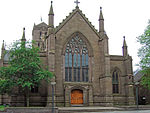St Andrew's Cathedral, Dundee
19th-century Roman Catholic church buildings in the United KingdomCategory B listed buildings in DundeeChurches in DundeeListed cathedrals in ScotlandRoman Catholic cathedrals in Scotland ... and 2 more
Roman Catholic churches completed in 1836Use British English from December 2017

The Cathedral Church of St Andrew is a Catholic cathedral in the West End of the city of Dundee, Scotland. The cathedral is the seat of the Bishop of Dunkeld and mother church of the Diocese of Dunkeld within the Province of St Andrews and Edinburgh. The bishop, since 9 January 2014, is Stephen Robson.
Excerpt from the Wikipedia article St Andrew's Cathedral, Dundee (License: CC BY-SA 3.0, Authors, Images).St Andrew's Cathedral, Dundee
Nethergate, Dundee University of Dundee Campus
Geographical coordinates (GPS) Address Nearby Places Show on map
Geographical coordinates (GPS)
| Latitude | Longitude |
|---|---|
| N 56.4574 ° | E -2.9748 ° |
Address
Dundee Contemporary Arts
Nethergate
DD1 4DU Dundee, University of Dundee Campus
Scotland, United Kingdom
Open on Google Maps








